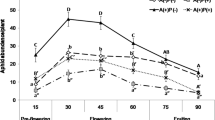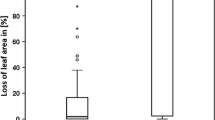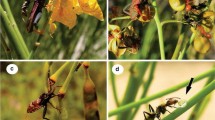Abstract
In ant–plant mutualisms mediated by plant-based liquid resources (e.g., extrafloral and pericarpial nectar), third-party exploiters are often present. Usually, the costs of having exploiters species seem to have little to no effect on ant–plant mutualistic interaction. However, little is known about how and to what extent exploiters affect mutualistic interactions. In this study, we evaluated the cascading effects of Rhinoleucophenga myrmecophaga (Diptera) predatory larvae on the outcomes of the interaction between mutualistic ants and a pericarpial nectary (PN)-bearing plant, Cordiera elliptica (Rubiaceae). In a manipulative experiment controlling for the presence of ants and/or predatory larvae, we evaluated arthropods and larvae, plant fitness, and pericarpial nectar production. We found that: (a) the presence of larvae decreased ant abundance by 50% resulting in an increase of arthropod number by 38%; (b) the absence of ants negatively influenced larva development and survival; (c) fruits with larvae and without ants had lower volume and weight, fewer viable seeds, and a higher parasitism rate; and (d) the pericarpial nectar sugar concentration is higher in plants with larvae and without ants. We showed that the outcomes of the multitrophic relationship between ants, R. myrmecophaga larvae, and an PN-bearing plant led to costly cascading effects on this mutualistic relationship. This interaction can range from negative to positive, in which the predatory fly larvae directly and indirectly influence ants number and behavior, and consequently the plant fitness.






Similar content being viewed by others
Data availability
The data supporting the results of this manuscript are archived in public repository Zenodo (https://doi.org/10.5281/zenodo.6785006).
References
Alvares CA, Stape JL, Sentelhas PC et al (2013) Köppen’s climate classification map for Brazil. Meteorol Zeitschrift 22:711–728. https://doi.org/10.1127/0941-2948/2013/0507
Alves-Silva E, Bächtold A, Del-Claro K (2018) Florivorous myrmecophilous caterpillars exploit an ant-plant mutualism and distract ants from extrafloral nectaries. Austral Ecol 43:643–650. https://doi.org/10.1111/aec.12609
Bates D, Maechler M, Bolker B, Walker S (2015) Fitting linear mixed-effects models using lme4. J Stat Softw. https://doi.org/10.18637/jss.v067.i01
Bazzaz FA, Grace J (1997) Plant resource allocation. Elsevier
Bazzaz FA, Chiariello NR, Coley PD, Pitelka LF (1987) Allocating resources to reproduction and defense. Bioscience 37:58–67. https://doi.org/10.2307/1310178
Bixenmann RJ, Coley PD, Kursar TA (2011) Is extrafloral nectar production induced by herbivores or ants in a tropical facultative ant-plant mutualism? Oecologia 165:417–425. https://doi.org/10.1007/s00442-010-1787-x
Borges RL, Jardim JG, Roque N (2017) Rubiaceae na Serra Geral de Licínio de Almeida, Bahia, Brasil. Rodriguesia 68:581–621. https://doi.org/10.1590/2175-7860201768220
Bronstein JL (1998) The contribution of ant plant protection studies to our understanding of mutualism. Biotropica 30:150–161
Bronstein JL (2001) The exploitation of mutualisms. Ecol Lett 4:277–287. https://doi.org/10.1046/j.1461-0248.2001.00218.x
Bronstein J (2015) The study of mutualism. In: Bronstein J (ed) Mutualism. Oxford University Press, New York, pp 3–19
Bronstein JL (2021) The gift that keeps on giving: why does biological diversity accumulate around mutualisms? In: Del-Claro K, Torezan-Silingardi HM (eds) Plant-Animal Interactions. Springer International Publishing, Cham
Bronstein J, Alarcón R, Geber M (2006) The evolution of plant-insect mutualisms. New Phytol 172:412–428. https://doi.org/10.1111/j.1469-8137.2006.01864.x
Brooks ME, Kristensen K, van Benthem KJ et al (2017) glmmTMB balances speed and flexibility among packages for zero-inflated generalized linear mixed modeling. R J 9:378–400
Byk J, Del-Claro K (2010) Nectar- and pollen-gathering Cephalotes ants provide no protection against herbivory: a new manipulative experiment to test ant protective capabilities. Acta Ethol 13:33–38. https://doi.org/10.1007/s10211-010-0071-8
Byk J, Del-Claro K (2011) Ant-plant interaction in the neotropical savanna: direct beneficial effects of extrafloral nectar on ant colony fitness. Popul Ecol 53:327–332. https://doi.org/10.1007/s10144-010-0240-7
Calixto ES, Lange D, Del-Claro K (2015) Foliar anti-herbivore defenses in Qualea multiflora Mart. (Vochysiaceae): changing strategy according to leaf development. Flora Morphol Distrib Funct Ecol Plants 212:19–23. https://doi.org/10.1016/j.flora.2015.02.001
Calixto ES, Lange D, Del-Claro K (2018a) Protection mutualism: an overview of ant-plant interactions mediated by extrafloral nectaries. Oecologia Aust 22:410–425. https://doi.org/10.4257/oeco.2018.2204.05
Calixto ES, Sousa-Lopes B, Del-Claro K (2018b) Are rare velvet ants (Hymenoptera: Mutillidae) to feed on extrafloral nectar? J Environ Anal Prog 3:406–409
Calixto ES, Lange D, Moreira X, Kleber D (2021a) Plant species-specificity of ant-plant mutualistic interactions: differential predation of termites by camponotus crassus on five species of extrafloral nectaried plants. Biotropica 53(5):1406–1414
Calixto ES, Lange D, Bronstein J et al (2021b) Optimal defense theory in an ant-plant mutualism: extrafloral nectar as an induced defense is maximized in the most valuable plant structures. J Ecol 109:167–178. https://doi.org/10.1111/1365-2745.13457
Calixto ES, Lange D, Del-Claro K (2021c) Net benefits of a mutualism: influence of the quality of extrafloral nectar on the colony fitness of a mutualistic ant. Biotropica 53:846–856. https://doi.org/10.1111/btp.12925
Calixto ES, Novaes LR, dos Santos DFB et al (2021d) Climate seasonality drives ant–plant–herbivore interactions via plant phenology in an extrafloral nectary-bearing plant community. J Ecol 109:639–651. https://doi.org/10.1111/1365-2745.13492
Del-Claro K, Torezan-Silingardi HM (2021) Plant-Animal Interactions. Springer International Publishing, Cham
Del-Claro K, Guillermo-Ferreira R, Almeida EM et al (2013) Ants visiting the post-floral secretions of pericarpial nectaries in Palicourea rigida (Rubiaceae) provide protection against leaf herbivores but not against seed parasites. Sociobiology 60(3):217–221
Del-Claro K, Rico-Gray V, Torezan-Silingardi HM et al (2016) Loss and gains in ant–plant interactions mediated by extrafloral nectar: fidelity, cheats, and lies. Insectes Soc 63:207–221. https://doi.org/10.1007/s00040-016-0466-2
Del-Claro K, Stefani V, Nahas L, Torezan-Silingardi HM (2017) Spiders as plant partners: Complementing ant services to plants with extrafloral nectaries. In: Viera C, Gonzaga MO (eds) Behaviour and Ecology od Spiders. Springer International Publishing, Cham, pp 215–226
Del-Claro K, Lange D, Torezan-Silingardi HM et al (2018) The complex ant-plant relationship within Tropical ecological networks. In: Dáttilo W, Rico-Gray V (eds) Ecological Networks In The Tropics: An Integrative Overview Of Species Interactions From Some Of The Most Species-Rich Habitats On Earth. Springer, Cham, pp 59–71
Del-Claro K, Rodriguez-Marales D, Calixto ES et al (2019) Ant pollination of Paepalanthus lundii (Eriocaulaceae) in Brazilian savanna. Ann Bot 123:1159–1165. https://doi.org/10.1093/aob/mcz021
Díaz-Castelazo C, Rico-Gray V, Ortega F, Ángeles G (2005) Morphological and secretory characterization of extrafloral nectaries in plants of coastal Veracruz, Mexico. Ann Bot 96:1175–1189. https://doi.org/10.1093/aob/mci270
Fagundes R, Dáttilo W, Ribeiro SP et al (2016) Food source availability and interspecific dominance as structural mechanisms of ant-plant-hemipteran multitrophic networks. Arthropod Plant Interact 10:207–220. https://doi.org/10.1007/s11829-016-9428-x
Fox J, Weisberg S (2011) An {R} companion to applied regression, Second. SAGE, California
Heil M (2015) Extrafloral nectar at the plant-insect interface: a spotlight on chemical ecology, phenotypic plasticity, and food webs. Annu Rev Entomol 60:213–232. https://doi.org/10.1146/annurev-ento-010814-020753
Heil M, Fiala B, Baumann B, Linsenmair KE (2000) Temporal, spatial and biotic variations in extrafloral nectar secretion by Macaranga tanarius. Funct Ecol 14:749–757. https://doi.org/10.1046/j.1365-2435.2000.00480.x
Keeler KH (1981) Function of Mentzelia nuda (Loasaceae) postfloral nectaries in seed defense. J B 68:295–299
Knauer AC, Bakhtiari M, Schiestl FP (2018) Crab spiders impact floral-signal evolution indirectly through removal of florivores. Nat Commun 9:1–10. https://doi.org/10.1038/s41467-018-03792-x
Koptur S (1992) Extrafloral nectary-mediated interactions between insects and plants. In: Bernays E (ed) Insect-Plant Interactions. CRC Press, Boca raton, pp 81–129
Koptur S (1994) Floral and extrafloral nectars of Costa Rican Inga trees a comparison of their constituents and composition. Biotropica 26:276–284
Lange D, Calixto ES, Del-Claro K (2017) Variation in extrafloral nectary productivity influences the ant foraging. PLoS ONE 12:1–13. https://doi.org/10.1371/journal.pone.0169492
Lenth R (2020) emmeans: Estimated Marginal Means, aka Least-Squares Means. In: R Packag. version 1.3.0. https://cran.r-project.org/package=emmeans
Louda SM (1982) Inflorescence spiders: a cost/benefit analysis for the host plant, haplopappus venetus blake (Asteraceae). Oecologia 55:185–191
Machado SR, Morellato LPC, Sajo MG, Oliveira PS (2008) Morphological patterns of extrafloral nectaries in woody plant species of the Brazilian cerrado. Plant Biol 10:660–673. https://doi.org/10.1111/j.1438-8677.2008.00068.x
Monique K, De Souza GR, Calixto ES, Silva EA (2022) Temporal variation in the effect of ants on the fitness of myrmecophilic plants : seasonal effect surpasses periodic benefits. Sci Nat 109:36. https://doi.org/10.1007/s00114-022-01805-w
Munique LB, Calixto ES (2018) Spatial and temporal variation of plant fragment removal by two species of Atta leaf-cutting ants. J Insect Behav 31:255–263. https://doi.org/10.1007/s10905-018-9673-1
Nation JL (2015) Insect physiology and biochemistry. CRC Press, Boca Raton
Ness JH, Morris WF, Bronstein JL (2009) For ant-protected plants, the best defense is a hungry offense. Ecology 90:2823–2831
Novaes LR, Calixto ES, de Oliveira ML et al (2020) Environmental variables drive phenological events of anemocoric plants and enhance diaspore dispersal potential: a new wind-based approach. Sci Total Environ. https://doi.org/10.1016/j.scitotenv.2020.139039
Oksanen J, Blanchet FG, Friendly M, et al (2018) vegan: Community Ecology Package. R package version 2.5–3. https://cran.r-project.org/package=vegan
Paiva EAS (2009) Ultrastructure and post-floral secretion of the pericarpial nectaries of Erythrina speciosa (Fabaceae). Ann Bot 104:937–944. https://doi.org/10.1093/aob/mcp175
Polis GA, Myers CA, Holt RD (1989) The ecology and evolution of intra guild predation: potential competitors that eat each other. Annu Rev Ecol Syst 20:297–330
R Core Team (2021) R: A language and environment for statistical computing
Rosumek FB, Silveira FAOO, Neves FDS et al (2009) Ants on plants: a meta-analysis of the role of ants as plant biotic defenses. Oecologia 160:537–549. https://doi.org/10.1007/s00442-009-1309-x
Sanz-Veiga PA, Ré Jorge L, Benitez-Vieyra S, Amorim FW (2017) Pericarpial nectary-visiting ants do not provide fruit protection against pre-dispersal seed predators regardless of ant species composition and resource availability. PLoS ONE 12:e0188445. https://doi.org/10.1371/journal.pone.0188445
Sousa-Lopes B, Calixto ES, Torezan-Silingardi H, Del-Claro K (2020) Effects of ants on pollinator performance in a distylous pericarpial nectary-bearing rubiaceae in Brazilian cerrado. Sociobiology 67(2):173–185
Trager MD, Bhotika S, Hostetler JA et al (2010) Benefits for plants in ant-plant protective mutualisms: a meta-analysis. PLoS ONE 5:e14308. https://doi.org/10.1371/journal.pone.0014308
Vidal MC, Vilela CR (2015) A new species of Rhinoleucophenga (Diptera: Drosophilidae) from the Brazilian cerrado biome associated with extrafloral nectaries of Qualea grandiflora (Vochysiaceae). Ann Entomol Soc Am 108:932–940. https://doi.org/10.1093/aesa/sav077
Vidal MC, Sendoya SF, Oliveira PS (2016) Mutualism exploitation: predatory drosophilid larvae sugar-trap ants and jeopardize facultative ant-plant mutualism. Ecology 97:1650–1657. https://doi.org/10.1515/gps-2013-0048
Vidal MC, Sendoya SF, Yamaguchi LF et al (2018) Natural history of a sit-and-wait dipteran predator that uses extrafloral nectar as prey attractant. Environ Entomol 47:1165–1172. https://doi.org/10.1093/ee/nvy097
Weber MG, Porturas LD, Keeler KH (2015) World list of plants with extrafloral nectaries. www.extrafloralnectaries.org. Accessed 22 Jun 2019
Acknowledgements
We thank Clube de Caça e Pesca Itororó de Uberlândia for providing the study area; Robert Marquis for his suggestions in the earlier versions of this manuscript.
Funding
This study was financed in part by “Coordenação de Aperfeiçoamento de Pessoal de Nível Superior – Brasil (CAPES)”—Finance Code 001 (ESC), and by CNPq (LAOF, DFBS) and CNPq/PQ (KDC).
Author information
Authors and Affiliations
Contributions
LAOF, ESC and KDC: conceived and designed the experiments. LAOF and DFBS: performed the experiments. ESC and DFBS: analyzed the data. LAOF: wrote the first draft of the manuscript. All authors contributed critically to the drafts and gave final approval for publication.
Corresponding author
Ethics declarations
Conflict of interest
The authors declare that they have no conflict of interest.
Additional information
Handling Editor: Abel Bernadou.
Publisher's Note
Springer Nature remains neutral with regard to jurisdictional claims in published maps and institutional affiliations.
Supplementary Information
Below is the link to the electronic supplementary material.
Rights and permissions
Springer Nature or its licensor holds exclusive rights to this article under a publishing agreement with the author(s) or other rightsholder(s); author self-archiving of the accepted manuscript version of this article is solely governed by the terms of such publishing agreement and applicable law.
About this article
Cite this article
Oliveira-Filho, L.A., Calixto, E.S., Santos, D.F.B. et al. Negative cascading effects of a predatory fly larva on an ant–plant protective mutualism. Arthropod-Plant Interactions 16, 373–385 (2022). https://doi.org/10.1007/s11829-022-09907-y
Received:
Accepted:
Published:
Issue Date:
DOI: https://doi.org/10.1007/s11829-022-09907-y




